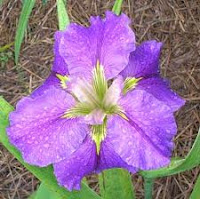February: Flower of the month
Iris
 |
| White Cut Flower Iris |
 |
| Wild Bearded Iris |
It should come as no surprise that the iris's three upright petals symbolize faith, valor and wisdom. With its majestic purple hues and soaring slender stem, this dignified and graceful February birth flower dates back to Ancient Greece, when Iris, the messenger of the gods and the personification of the rainbow (the Greek word for Iris), acted as the link between heaven and earth. She was faster than the fastest wind and able to travel from the depths of the underworld, to the sea, and to the dry places we live in. She was known for her color and her ability to be anywhere.
What better name could have been given the humble plant we call iris today in her honor. A species so varied and colorful no one garden can contain them all. They can be found native in all areas of Africa, Asia, the Americas, Europe, and the Middle East. They can be found in the wettest of places, even fully living in water, to the driest rocky crags. They have found a home in every civilization that knew them--often with high regard and care. Let’s take a deeper look at some of the major varieties of iris available to the modern gardener today.
 |
| Juno |
Juno – These are some of the easiest and best bulbous Iris to grow. Sadly, they are also one of the rarest iris in modern gardens today. They don’t like wet spots and grow in everything from clay to lose soils. Their plants give a strong resemblance to tiny corn plants. Almost all of them bloom in mid-spring and are crested. They all love full sun.
 |
Louisiana |
| Louisiana Iris |
Louisiana – By far my favorite iris, these lovelies grow in both semi-dry locations and right in the water. They will not bloom when conditions are dry for long periods of time but they can take short periods of dryness. In the right, rich, wet soil these iris take off and will quickly fill out their space. They bloom in mass and are stunning when you see them reflecting off the water.
 |
| Aril Iris |
Aril – These are some of the hardest iris to grow outside of their native range. They are known for their rare beauty and the strange white marking on their seeds. They need fast draining soil and little to no water all summer long. They make their home in Israel and the Middle East. There are no photos of any aril iris in plant files that I could find – challenge anyone?
 |
| Reticulata iris |
Reticulata – These are dwarf iris with big bold purple or blue blooms. They are from Turkey and like it on the dry side but will grow and multiply given half a chance. They are quite noticeable for their squareish flowers.
 |
| Bearded Iris |
Bearded – The most common and the most colorful of all the iris branches are the bearded. They come in all heights, shapes, and almost all colors. These iris are the backbones of many old fashion American gardens.
 |
| Spuria Iris |
Spuria – This iris blooms well in most parts of the country. They come from Southern Europe all the way to the mountains of Afghanistan. They have been grown for years in areas as varied as Japan and Rumania.
 |
| Siberian Iris |
Siberian – These are iris better suited to the colder Northern areas of the world. They don’t like heat and they thrive in the coldest of winters. They are common in many gardens and are often given as pass-me-down plants.
| Evansias Iris |
Evansias – These iris are commonly called crested and look somewhat like orchids in bloom. Their blooms range from very small to almost a foot in size and their leaves are evergreen. They are one of those flowers that you either love or hate; you see orchids or rooster-comb-like, messy flowers.
 |
| Japanese Iris |
Japanese – These are easy to grow iris if you have the right place. The greatest need is soil a little on the acid side. The soil needs to be moist, but not waterlogged at all times. They need fast drainage, but not too fast. On the whole, if you have a place they love, they will reward you with some of the most stunning flowers in the iris kingdom.
 |
| Pacific Coast |
Pacific Coast – These are the pickiest iris most gardeners will ever try to grow. They are easy to grow, bloom fast from seed, and are carefree – in the moist and mild areas they call home. However, they cannot take cold, heat, dry, or wet, well at all. They are stunning and can be grown in any area given a lot of prep, protection, and daily care. These iris, like the Aril, are not worth growing for most common gardeners outside of their native zone.

